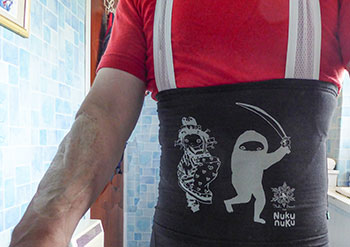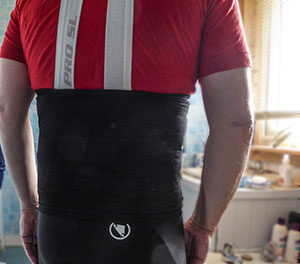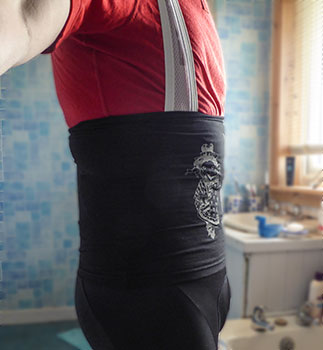
..........................................................................................................................................................................................................
haramaki - japanese body warmer

at its most basic level, the layering system consists of a base-layer, mid-layer and, every bit as importantly, the outer layer. it's a system that evolved principally for those enamoured with the great outdoors and there are more than a few companies or individuals who claim to have 'invented' it. however, since pretty much every outdoor clothing purveyor adheres to its benefits, the originator matters little. well, other than whoever did invent it, of course.
though i've no doubt there will be those clamouring to disagree, the average cyclist suffers from breathability/perspirational issues to a greater extent than those who trek across great wastelands, or bag a couple of munros at the weekend. therefore, though the layering system applies every bit as much to the velocipedinally inclined, it's possible that clothing apportioned to the latter, may need the occasional tweek here or there. and it's no real secret that the holy grail for both, is the fabrication of a breathable outer-layer that is breathable enough for a cyclist making his or her way to the summit of the monte zoncolan in twenty-degree heat in the rain.
based on current technology, that grail is still some way off.
it may possibly be, however, that we are looking the wrong way. a few years past, development of the outer layer took a slight diversion, admitting that ultimately, it could not maintain total waterproofing indefinitely; eventually, any coated, waterproof fabric, cannot shed precipitation faster than it is being absorbed. that's when we get wet. accepting that to be a currently unsolvable fact, the clever money started looking at the likelihood of creating a material that would keep the individual comfortable even when wet.

look back to milan-sanremo around five years ago, and take note of the jacket favoured even by those sponsored by other manufacturers. that jacket was/is not 100% waterproof, but it hides that fact well until you reach the finish line.
but how comfortable we remain, if that outer layer features even a modest level of thermal properties, might well depend on our choice of base-layer. this mostly consists, at present, of the highly comfortable and distinctly non-aromatic merino wool version and the various polyester versions; offer a choice between both and i figure you'd probably have two lines of equal length standing in front of you. but ultimately, it's maintaining a stable core temperature when riding in cold weather that is the most important aspect. there's no real point in remaining dry, if hypothermia gets to you first.
the japanese word haramaki, means 'belly-wrap, a stretchy cotton tube that is worn around the stomach and purports to maintain warmth in the face of adversity. i'd be loathe to wear one without matching it with a base-layer of some sort, if only for reasons of upper body comfort, but it pretty much seems to do what it says on the tin. though many will purport that wearing a base-layer of thicker material would surely offer the same benefits, that would likely risk serious overheating under strenuous conditions. back to the zoncolan summit once more.

the haramaki, available in several colour variants, is thin enough not to have your hard won svelte physique resemble that of billy bunter and, according to the distributors, is suitable for activities other than just cycling, something that could also legitimately be said about base-layers too. those months that encompass the spring classics are ideal for this item, as are those in the depths of mid-winter. once on, it's comfortable and stretchy enough to all but forget its existence, though it's worth my pointing out that, on a day that started cold, but heated up, my six-pack became a tad warmer than i'd prefer.
however, assuming, like me, you wear it over your bibshorts or bibtights, it's a relatively simple process to divest yourself of its benefits and stuff it in a back pocket. i'm not sure that i see it becoming a staple in the active cyclist's sock drawer; it's perhaps better suited to the commuting or leisure cyclist during the colder months, since they're less likely to benefit from the almost hermetic sealing of a clothing groupset. but at £12.50 each, it's definitely worth investigating for next winter.
sunday 20 may 2018
 ..........................................................................................................................................................................................................
..........................................................................................................................................................................................................